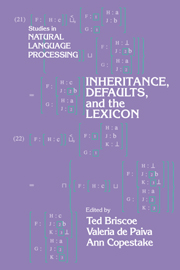Book contents
- Frontmatter
- Contents
- Contributors
- 1 Introduction
- 2 Skeptical and Credulous Default Unification with Applications to Templates and Inheritance
- 3 Prioritised Multiple Inheritance in DATR
- 4 Some Reflections on the Conversion of the TIC Lexicon into DATR
- 5 Norms or Inference Tickets? A Frontal Collision between Intuitions
- 6 Issues in the Design of a Language for Representing Linguistic Information Based on Inheritance and Feature Structures
- 7 Feature-Based Inheritance Networks for Computational Lexicons
- 8 A Practical Approach to Multiple Default Inheritance for Unification-Based Lexicons
- 9 The ACQUILEX LKB: An Introduction
- 10 Types and Constraints in the LKB
- 11 LKB Encoding of Lexical Knowledge
- 12 Defaults in Lexical Representation
- 13 Untangling Definition Structure into Knowledge Representation
- Appendix A A Bibliography of ACQUILEX Papers Connected with the LKB
- Appendix B The LKB Description Language Syntax
- Appendix C Software Availability
- References
- Author index
- Subject Index
6 - Issues in the Design of a Language for Representing Linguistic Information Based on Inheritance and Feature Structures
Published online by Cambridge University Press: 01 April 2010
- Frontmatter
- Contents
- Contributors
- 1 Introduction
- 2 Skeptical and Credulous Default Unification with Applications to Templates and Inheritance
- 3 Prioritised Multiple Inheritance in DATR
- 4 Some Reflections on the Conversion of the TIC Lexicon into DATR
- 5 Norms or Inference Tickets? A Frontal Collision between Intuitions
- 6 Issues in the Design of a Language for Representing Linguistic Information Based on Inheritance and Feature Structures
- 7 Feature-Based Inheritance Networks for Computational Lexicons
- 8 A Practical Approach to Multiple Default Inheritance for Unification-Based Lexicons
- 9 The ACQUILEX LKB: An Introduction
- 10 Types and Constraints in the LKB
- 11 LKB Encoding of Lexical Knowledge
- 12 Defaults in Lexical Representation
- 13 Untangling Definition Structure into Knowledge Representation
- Appendix A A Bibliography of ACQUILEX Papers Connected with the LKB
- Appendix B The LKB Description Language Syntax
- Appendix C Software Availability
- References
- Author index
- Subject Index
Summary
Abstract
In this chapter, we address some issues in the design of declarative languages based on the notion of inheritance. First, we outline the connections and similarities between the notions of object, frame, conceptual graph and feature structures and we present a synthetic view of these notions. We then present the Typed Feature Structure (TFS) language developed at the University of Stuttgart, which reconciles the object-oriented approach with logic programming. We finally discuss some language design issues.
Convergences
Developing large NLP software is a very complex and time consuming task. The complexity of NLP can be characterized by the following two main factors:
NLP is data-intensive. Any NLP application needs large amounts of complex linguistic information. For example, a realistic application has typically dictionaries with tens of thousands of lexical entries.
Sophisticated NLP applications such as database interfaces or machine translation build very complex and intricate data structures for representing linguistic objects associated to strings of words. Part of the complexity also lies in the processing of such objects.
Object-oriented Approaches
An object-oriented approach to linguistic description addresses these two sources of complexity by providing:
facilities to manage the design process: data abstraction and inheritance.
facilities for capturing directly the interconnections and constraints in the data: properties, relations and complex objects. These features are common to object-oriented languages (OOL), objectoriented database management systems (OODBMS) or knowledge representation languages (KRL).
- Type
- Chapter
- Information
- Inheritance, Defaults and the Lexicon , pp. 74 - 89Publisher: Cambridge University PressPrint publication year: 1994



